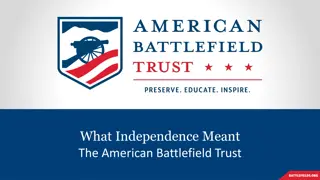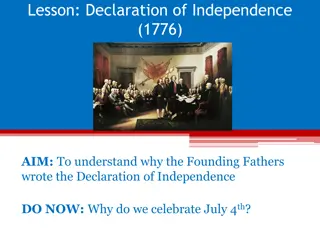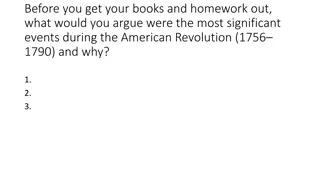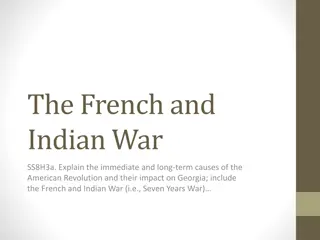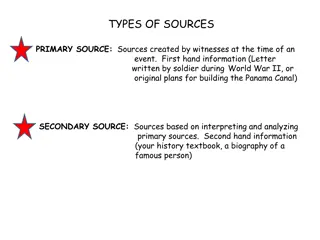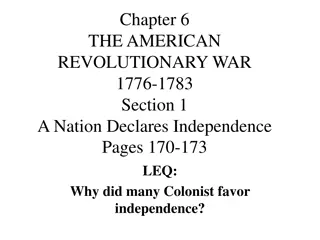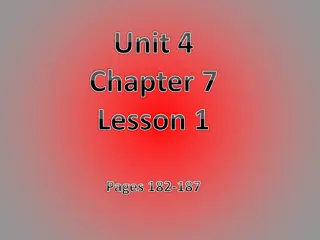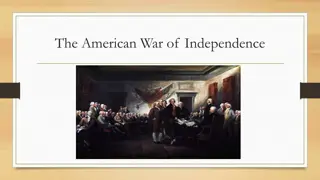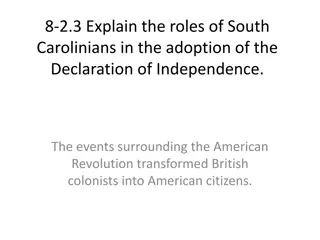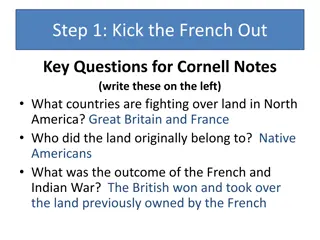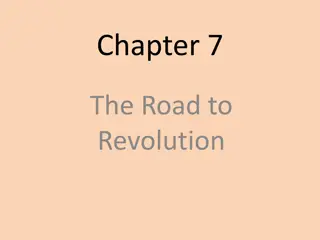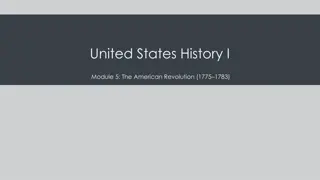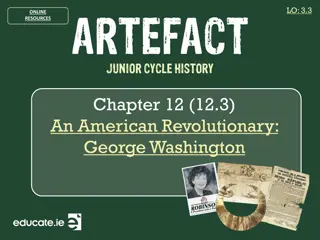The American Revolution: Overcoming Odds and Achieving Independence
Despite facing significant challenges, including lack of military experience and unity, the American patriots managed to defeat the formidable British Empire in the Revolutionary War. Key turning points such as the victories at Saratoga, French alliance, and the surrender of Cornwallis led to America's independence in 1783.
Download Presentation

Please find below an Image/Link to download the presentation.
The content on the website is provided AS IS for your information and personal use only. It may not be sold, licensed, or shared on other websites without obtaining consent from the author.If you encounter any issues during the download, it is possible that the publisher has removed the file from their server.
You are allowed to download the files provided on this website for personal or commercial use, subject to the condition that they are used lawfully. All files are the property of their respective owners.
The content on the website is provided AS IS for your information and personal use only. It may not be sold, licensed, or shared on other websites without obtaining consent from the author.
E N D
Presentation Transcript
How could the Americans ever hope defeat the mighty British Empire in a military conflict? Americans faced seemingly impossible obstacles. When the guns fired at Lexington and Concord in 1775, there was not yet even a Continental Army. Those battles were fought by local militias.
Few Americans had any military experience, and there was no method of training, supplying, or paying an army. Moreover, a majority of Americans opposed the war in 1775. Further, the Colonies had a poor track record of working together. How, then, could a ragtag group of patriots defeat the British?
The early stages of war, in 1775, can be best described as British military victories and American moral victories . The British routed the minutemen at Lexington, but suffered sniper fire on their return to Boston from Concord. In June 1775, the colonists lost at Bunker Hill, but inflicted heavy casualties on the British.
A year later, in 1776, George Washington led his army to two surprise victories at Trenton and Princeton. These victories provide a morale boost. By 1777, the British occupied Philadelphia and New York City and controlled the waters along the Eastern Seaboard.
The Battle of Saratoga (New York) served as a critical turning point in the war. The British attempt to capture the Hudson River Valley ended with their surrender to General Horatio Gates in October. George Washington, having lost Philadelphia, led his troops to Valley Forge to spend the winter.
None of the world's powers had come to the aid of the patriot cause yet. In early 1778, the French agreed to recognize American independence and formed a permanent alliance with the new nation. Military help and sizable stores of much- needed gunpowder soon arrived. The tide was beginning to turn.
In October 1781, the war came to an end when General Cornwallis was surrounded by the American forces on the ground and the French by the sea. This forced Cornwallis to surrender at Yorktown, Virginia. Two years later, the Treaty of Paris made it official: America was independent.
The British seemed unbeatable. Britain's military was the best in the world. Their soldiers were well equipped, well disciplined, well paid, and well fed. The British navy dominated the seas. Some of those funds were used to hire sHessian mercenaries to fight the Americans.
Britain's General Gage had a secret plan. During the early hours of April 19, 1775, Gage would send out regiments of British soldiers quartered in Boston. Their destinations were Lexington, where they would capture Colonial leaders Sam Adams and John Hancock. Then on to Concord, where they would seize gunpowder.
But spies and friends of the Americans leaked word of Gage's plan. Two lanterns hanging from Boston's North Church informed the countryside that the British were going to attack by sea. A series of horseback riders men such as Paul Revere, John Warren, etc galloped off to warn the countryside that the Regulars (British troops) were coming.
Word spread from town to town, and militias prepared to confront the British. Selected members of the militia were called minutemen in a minute's time. minutemen because they could be ready to fight Sure enough, when the advance guard of nearly 240 British soldiers arrived in Lexington, they found about 70 minutemen formed on the Lexington Green awaiting them.
Both sides eyed each other, not knowing what to expect. Suddenly, a bullet buzzed through the morning air. It was "the shot heard round the world the shot heard round the world."
The numerically superior British killed seven Americans at Lexington. They marched off to Concord with new regiments who had joined them. American militias arriving at Concord thwarted the British advance.
Indignation against the British ran high in the Colonies for they had shed American blood on American soil. Radicals such as Sam Adams took advantage of the bloodshed to increase tensions through propaganda and rumor-spreading.
As the British retreated toward Boston, new waves of Colonial militia intercepted them. Shooting from behind fences and trees, the militias inflicted over 125 casualties, including several officers. The ferocity of the encounter surprised both sides.
During the battles of Lexington and Concord, 73 British soldiers had been killed and 174 wounded; 26 were missing. Lord Percy, who led the British back into Boston after the defeat suffered at Concord, wrote back to London, "Whoever looks upon them [the Rebels] as an irregular mob will be much mistaken."
Three British major generals 1. William Howe 2. Henry Clinton 3. "Gentleman Johnny" Burgoyne were brought to Boston to lend their expertise and experience to the situation.
On the night of June 16, 1775, a detail of American troops moved out of their camp, carrying picks, shovels, and guns. They entrenched themselves on a rise located on Charleston Peninsula overlooking Boston. Their destination: Bunker Hill Bunker Hill.
From this hill, the rebels could bombard the town and British ships in Boston Harbor. But the colonists misunderstood the officers orders. They went to Breed's Hill by mistake and entrenched themselves there closer to the British position.
The next morning, the British were stunned to see Americans threatening them. In the 18th century, British military custom demanded that the British attack the Americans Even though the Americans were in a superior position militarily (the Americans had soldiers and cannon pointing down on the British).
Major General William Howe, leading the British forces, could have easily surrounded the Americans with his ships at sea. But instead chose to march his troops uphill. Howe believed that the Americans would retreat in the face of a smashing, head-on attack. He was wrong.
Early in the afternoon, 28 ships of British soldiers crossed the Charles River and stormed the hills. The Americans waited until the British were within 15 paces, and then unleashed a bloody attack. Scores of British troops were killed or wounded; the rest retreated down the hill. Again, the British rushed the hill in a second wave. And again they retreated, suffering a great number of casualties.
Again, the British rushed the hill in a second wave. And again they retreated, suffering a great number of casualties.
By the time the third wave of British charged the hill, the Americans were running low on ammunition. Hand-to-hand fighting ensued. The British eventually took the hill, but at a great cost. Of the 2,300 British soldiers who had gone through the ordeal, 1,054 were either killed or wounded.
On July, 2, 1775, George Washington took command of the new American army. He had a formidable task ahead of him. He needed to establish a chain of command and determine a course of action for a war if there would be a war.
In London, the news of Bunker Hill convinced the king that the situation in the Colonies had escalated into an organized uprising and must be treated as a foreign war. Accordingly, he issued a Proclamation of Rebellion.
American spirits reached a low point during the harsh winter of 1777-78. British troops had marched into Philadelphia the previous autumn. Philadelphia was the largest city in the Colonies and the seat of political power. After the British swept into Philadelphia, the Continental Congress had flee to west, first to Lancaster then to York.
Washington's army had spent the summer of 1777 fighting a string of losing battles. The Americans were unable to keep the British out of Philadelphia. In December, Washington marched his tired, beaten, hungry and sick army to Valley Forge location about 20 miles northwest of British- occupied Philadelphia. Valley Forge, a From Valley Forge, Washington could keep an eye on the British army in Philadelphia.
General Washington was upset that local farmers were hoarding much- needed food waiting to earn higher profits in the spring. Some farmers even sneaked grain into Philadelphia to feed the British army, who paid in gold or silver.
With each passing night came more desertions. Washington grew privately disgusted at the lack of commitment of his so-called patriot fighters. Washington's leadership skills were openly questioned. Many said General Horatio Gates was better- suited to leading the army.
Within the environment of cold, deprivation, and rebellion, how long could Washington and his army endure? Help came in the form of a Prussian volunteer, Baron von Steuben The military leader was shocked at the lack of American discipline. At Washington's urging he trained the Continental Army, Prussian-style. The troops slowly became more professional. Among the soldiers who remained, confidence grew. Baron von Steuben.
Over the course of the winter, the weather improved somewhat. Food trickled in from the surrounding countryside. Washington was able to quash those who questioned his leadership abilities.
The Continental Army at Valley Forge was about 12,000 men. Death claimed about 25% (3,000) of them before spring arrived. Another 1,000 didn't reenlist or deserted. But the army that remained was stronger. They were fewer, but more disciplined.
The next year, 1778, brought greater fortune to the American cause. While Washington froze at Valley Forge, Benjamin Franklin was busy securing the French alliance. Now the war would be different indeed.
The Battle of Saratoga was the turning point of the Revolutionary War. On October 17, 1777, 5,895 British and Hessian troops surrendered their arms. The victory gave new life to the American cause at a critical time. Americans had just suffered a major setback the Battle of the Brandywine along with news of the fall of Philadelphia to the British.
An American victory in October 1777, the success at Saratoga gave France the confidence in the American cause to enter the war as an American ally ally. Later American successes owed a great deal to French aid in the form of financial and military assistance.
Nowhere was the victory at Saratoga more noted than in France, which had been tentative in its efforts to assist the Americans. France's interest in the American fight for independence came from France's defeat during the Seven Years War at the hands of its ancient enemy, England.


